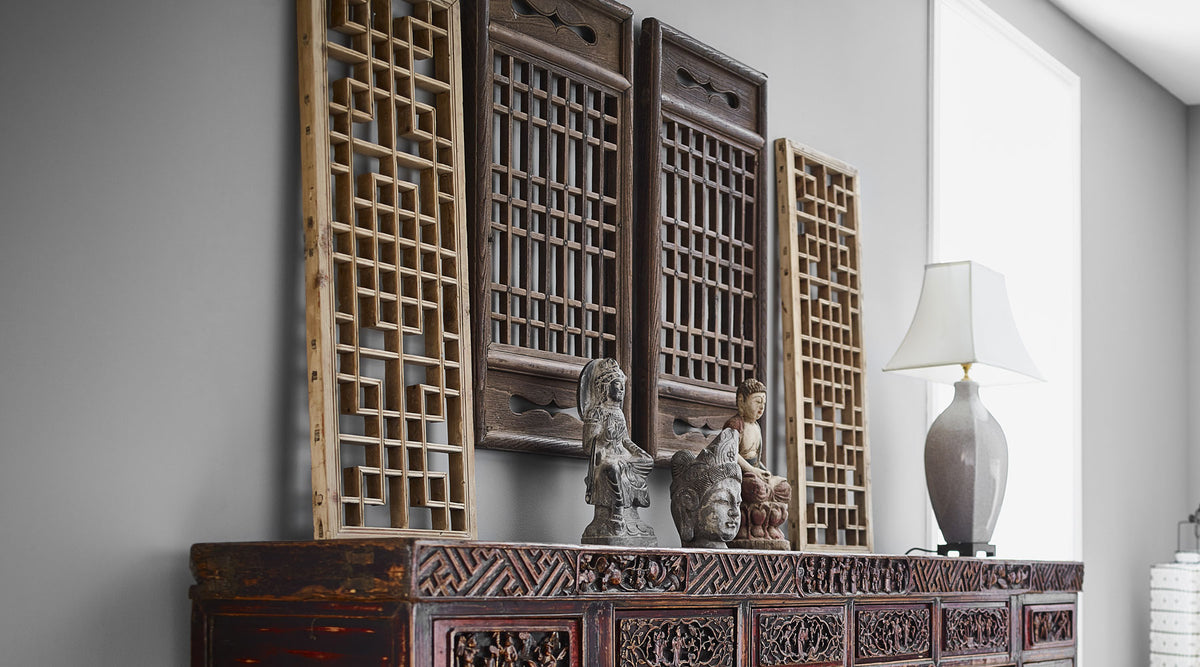
Add an instant oriental element to your home with Chinese screens and panels
When we think of Chinese interiors and oriental style home décor, we imagine dark woods and sleek surfaces in black or red lacquer with gold paintings, rich silks, blue and white porcelain and the soft lighting of Chinese lanterns. Another key element of the style though are the wonderful latticework panels and screens that form an intrinsic part of many traditional Chinese homes. For the modern home these offer a simple, effective way to bring an element of the style to an interior without being overpowering.
Folding screens originated in ancient China as a way to easily section off parts of an interior. Being portable, they could be positioned as required and the large panels offered a perfect surface for lacquering techniques and for beautifully detailed paintings – often with a mythical or historical theme. Chinese coromandel screens later became popular in western society, often seen in the great houses of Europe. Our own reproduction screens are faithful interpretations of old designs, with lattice panels or solid screens in black or red lacquer, beautifully decorated with butterflies as a symbol for long life and marital happiness. They are perfect as room dividers to provide privacy or to create a separate, distinctive space in a large room, or even used behind a bed as a feature wall.
Intricate, carved latticework is a common feature in Chinese interiors, seen both on a large scale as part of interior walls and window panels, or on smaller items such as cabinet doors. In wealthy homes across China, interior lattice window shutters would open out over an inner courtyard, while traditional Chinese canopy beds would often incorporate lattice designs or fretwork into the wooden panels, with geometric or floral patterns a popular design.
Old interior window shutters in a modern home make a wonderful architectural feature or decorative panel on a wall, giving a distinctive oriental look and offering an interesting alternative to paintings or photos. They can also be hung from a ceiling as a subtle divider or perhaps as an accent piece over a table, throwing unusual shadows in the soft evening light.
We have a wide range of antique Chinese panels in various shapes and sizes that are perfect for this purpose. Many are in simple, traditional lattice designs, crafted with individual pieces of wood fitted together with mortise and tenon joints, while others show more intricate and detailed carvings in floral designs or display auspicious animal symbols such as bats for good luck or the mythical ‘kylin’. Made from various woods including pine, elm and camphor (a popular wood for carved elements), the panels are usually in their original finish or stripped back to the natural colour of the material. Our collection includes both individual, large panels as well as sets of old window shutters that make a stunning wall feature over an altar table or sideboard.
Our Chinese Classical range of furniture in elm and black lacquer finishes also includes reproductions of traditional panels for a more modern take on the traditional look. The ‘cracked ice’ design used in our newly made panels is centuries old and named after its random latticework. It was developed as early as the Song dynasty, inspired by the crackled glaze effect seen on many Chinese ceramics. It was highly popular in China during the Ming and Qing dynasties and is still seen today not only in furniture and interiors but also incorporated into architecture – think of the ‘Bird’s Nest’ National Stadium used for the Beijing Olympics. Today our panels are perfect as a feature over a mantel piece or hung over one of our oriental cabinets.
These wonderful screens and panels, with instantly recognisable styles that date back hundreds of years, offer a simple way to inject character and even a sense of history into your interior space. You can see our full collection of both antique and new panels online and look out for other pieces as we regularly source and ship more from our partners in China.










Leave a comment